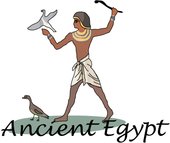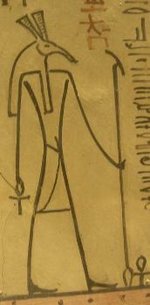Set (mythology)
|
|
In Egyptian mythology, Set (also spelt Sutekh, Setesh) is an ancient god, who was originally the god of the desert, one of the two main biomes that constitutes Egypt, the other being the small fertile area either side of the Nile. Due to developments in the Egyptian language over the 3000 years that the existance of Set was believed in, by the Greek period, the t in Set was pronounced so indistinguishably from th that the greeks spelt it this way, as Seth.
| Contents |
Desert god
As the god of the desert, Set was associated with sandstorms, and desert caravans. Due to the extreme hostility of the desert environment, Set was viewed as immensly powerful, and was regarded consequently as the chief god. One of the more common epithets was that he was great of strength, and in one of the Pyramid Texts it states that the king's strength is that of Set. As chief god, he was patron of Lower Egypt, where he was worshipped, most notably at Ombos. The alternate form of his name, spelt Setesh (stš), and later Sutekh (swtḫ), designates this supremecy, the extra sh and kh signifying majesty. The exact translation of Set is unknown for certain, but is usually considered to be either (one who) dazzles or pillar of stablity, one connected to the desert, and the other more to the institution of monarchy.
Set formed part of the Ennead of Heliopolis, as a son of the earth (Geb) and sky (Nuit), husband to the fertile land around the Nile (Nepthys), and brother to death (Osiris), and life (Isis). Since he represented the desert, he was generally considered infertile, and so, since the early Egyptians had very little in the way of taboos regarding sexuality, Set was usually identified as being homosexual, later gaining a partner, in the form of the Libyan god, Ash. It was said that Set's favourite food was lettuce, as Egyptian lettuce is long, firm, and releases a milky substance when rubbed, an innuendo clearly referring to the phallus.
The word for desert, in Egyptian was dshrt, which is very similar to the word for red, dshr (in fact, it has the appearance of a feminine form of the word for red). Consequently, Set became associated with things that were red, including people with ginger hair, which is not an attribute that egyptians generally had, and so he became considered to also be a god of foreigners.
Set's attributes as desert god lead to him also being associated with gazelles, and donkeys, both creatures living on the desert edge. Since sandstorms were said to be under his control as lord of the desert, and were the main form of storm in the dry climate of egypt, during the Ramesside Period (i.e., Dynasties 19 and 20), Set was identified as various Canaanite storm deities, including Resheph.
The Set animal
In art, Set was mostly depicted as a mysterious and unknown creature, referred to by Egyptologists as Set animal, with a curved snout, square ears, forked tail, and canine body, or sometimes as a human with only the head of the Set animal. It has no complete resemblence to any known creature, although it does resemble a composite of an aardvark, and a jackal, both of which are desert creatures, and the main species of aardvark present in ancient Egypt additionally had a reddish appearance (due to thin fur, which shows the skin beneath it). The earliest known representation of Set comes from a tomb dating to the Naqqada I phase of the Predynastic Period (circa 4000–3500 BCE), and the Set-animal is even found on a mace-head of the Scorpion King, a Protodynastic ruler.
A new theory has it that the head of the Set animal is a representation of the Mormyrus kannamae (Nile Mormyrid), which resides in the waters near Kom Ombos, one of the sites of a Temple of Set, with the two square fins being what are normally interpreted as ears. However, it may be that part or all of the Set animal was based on the Salawa, a similarly mysterious canine creature, with forked tail and square ears, one member of which was claimed to have been found and killed in 1996 by the local population of a region of Upper Egypt. It may even be the case that Set was originally neither of these, but later became associated with one or both of them due to their similar appearance.
Contestings of Horus and Set
After Lower Egypt, and Upper Egypt, were unified, by the conquest of the lower half, by the Upper, a representation of this conflict arose in mythology. Horus, who was the chief god of Upper Egypt, was depicted as having fought long and hard against Set in the struggle for the crown. It was said that in the struggle, Set's testicles were ripped off, explaining his infertility, as the desert, and one of Horus' eyes was parly gourged out, explaining why the moon was not as bright as the sun, since Horus, in this early form, was said to have the sun and the moon as his eyes. Ultimately, like the nations, the two gods were reconciled.
It was also said, during these contendings of Horus and Set, that Set had sought to support his claim to the throne by showing Horus was submissive to him, and consequently seduced Horus, with lines like How lovely your backside is. They had interfemoral intercourse, with Set taking the top role, but Horus secretly caught Set's semen, when he ejaculated, and throws it in the river. Subsequently, Horus masturbates, and secretly places his resulting semen onto lettuce, which Set then unknowingly eats, as it was his favourite food. To prove his dominance to the other gods, Set explains to them that Horus submitted to his advances, and calls forth his semen as evidence, but it answers from the river. Horus then calls his own semen forth, which answers from inside Set, making the gods feel that Horus was the dominant one, and therefore the rightful heir. In later versions of this myth, it is Thoth's magic that causes the semen to respond.
Saviour of Ra
As the Ogdoad system became more assimilated with the Ennead one, as a result of creeping increase of the identification of Atum as Ra, itself a result of the joining of Upper and Lower egypt, Set's position in this became considered. With Horus as Ra's heir on earth, Set, previously the chief god, for Lower Egypt, required an appropriate role as well, and so was identified as Ra's main hero, who fought Apep each night, during Ra's journey (as sun god) across the underworld.
He was thus often depicted standing on the prow of Ra's night barque spearing Apep in the form of a serpent, turtle, or other dangerous water animal. Surprisingly, in some Late Period representations, such as in the Persian Period temple at Hibis in the Khargah Oasis, Set was represented in this role with a falcon's head, taking on the guise of Horus, despite the fact that Set was usually considered in quite a different position with regard to heroism.
This assimilation also lead to Anubis being deplaced, in areas where he was worshipped, as ruler of the underworld, with his situation being explained by his being the son of Osiris. As Isis represented life, Anubis' mother was identified instead as Nepthys, leading to an explanation in which Nepthys, frustrated by Set's lack of sexual interest in her, disguised herself as the more attractive Isis, but failed to gain Set's attention, as Set was gay. Osiris, on the other hand, thought she was Isis, and they had sex, resulting in Anubis' birth. In some later texts, after Set lost the connection to the desert, thus infertility, and thus his sexuality, Anubis was identified as Set's son, as Set is Nepthys' husband.
God of Evil
Naturally, when, during the Second Intermediate Period the mysterious foreign Hyksos gained the rulership of Egypt, and ruled the Nile delta, from Avaris, they chose Set, originally Lower Egypt's chief god, as their patron, and so Set became worshipped as the chief god once again. However, following this invasion of the Hyksos, Egyptian attitudes towards foreigners could be best described as xenophobic, and eventually the Hyksos were deposed. During this period, Set, previously a hero, as the Hyksos' patron came to embody all that the Egyptians disliked about the foreign rulers, and so he gradually absorbed the identities of all the previous evil gods, particularly Apep.
When the Legend of Osiris and Isis grew up, Set was consequently identified as the killer of Osiris in it, having hacked Osiris' body into pieces, dispersing them, so that he could not be resurrected. Interpreting the ears as fins, the head of the Set-animal resembles the Oxyrhynchus fish, and so it was said that as a final precaution, an Oxyrhynchus fish ate the part that was Osiris' penis, the part which Set, as an homosexual, liked most.
Now that he had become the embodiement of evil, Set was consequently sometimes depicted as one of the creatures that the Egyptians most feared, crocodiles, and hippopotamus, and by the time of the New Kingdom, he was often associated with the villainous gods of other rising empires. One such case was Baal, an identification in which Set was described as being the consort of ‘Ashtart or ‘Anat, wife of Baal. Set was also identified by the Egyptians with the Hittite deity Teshub, who was a viscious storm god, as was Set. The Greeks later linked Set with Typhon because both were evil forces, and storm deities, that attacked the main gods, though they are not otherwise very similar.
Some scholars hold that after Egypt's conquest by the Persian ruler Cambyses II, Set also became associated with foreign oppressors, including the Achaemenid Persians, Ptolemaic Greeks, and Romans. Indeed, it was during the Græco-Roman Period that Set was particularly vilified, and his defeat by Horus widely celebrated. Nethertheless, throughout this period, in some distant locations he was still regarded as the heroic chief deity, for example, there was a temple dedicated to Set in the village of Mut al-Kharab, in the Dakhlah Oasis.
See also
Ancient Egypt Clipart and Pictures
- Ancient Egypt Architecture (http://classroomclipart.com/cgi-bin/kids/imageFolio.cgi?direct=History/Ancient_Civilizations/Ancient_Egypt/Architecture)
- Ancient Egypt Art (http://classroomclipart.com/cgi-bin/kids/imageFolio.cgi?direct=History/Ancient_Civilizations/Ancient_Egypt/Art)
- Ancient Egypt Clipart (http://classroomclipart.com/cgi-bin/kids/imageFolio.cgi?direct=History/Ancient_Civilizations/Ancient_Egypt/Clipart)
- Ancient Egypt Clothing (http://classroomclipart.com/cgi-bin/kids/imageFolio.cgi?direct=History/Ancient_Civilizations/Ancient_Egypt/Clothing)
- Ancient Egypt Architecture (http://classroomclipart.com/cgi-bin/kids/imageFolio.cgi?direct=History/Ancient_Civilizations/Ancient_Egypt/Commerce)
- Ancient Egypt Daily Life (http://classroomclipart.com/cgi-bin/kids/imageFolio.cgi?direct=History/Ancient_Civilizations/Ancient_Egypt/Daily_Life)
- Ancient Egypt Games and Toys (http://classroomclipart.com/cgi-bin/kids/imageFolio.cgi?direct=History/Ancient_Civilizations/Ancient_Egypt/Games_and_Toys)
- Ancient Egypt Hieroglyphs (http://classroomclipart.com/cgi-bin/kids/imageFolio.cgi?direct=History/Ancient_Civilizations/Ancient_Egypt/Hieroglyphs)
- Ancient Egypt People (http://classroomclipart.com/cgi-bin/kids/imageFolio.cgi?direct=History/Ancient_Civilizations/Ancient_Egypt/Historical_People)
- Ancient Egypt Illustrations (http://classroomclipart.com/cgi-bin/kids/imageFolio.cgi?direct=History/Ancient_Civilizations/Ancient_Egypt/Illustrations)
- Ancient Egypt Mummies (http://classroomclipart.com/cgi-bin/kids/imageFolio.cgi?direct=History/Ancient_Civilizations/Ancient_Egypt/Mummies)
- Ancient Egypt Musical Instruments (http://classroomclipart.com/cgi-bin/kids/imageFolio.cgi?direct=History/Ancient_Civilizations/Ancient_Egypt/Musical_Instruments)
- Ancient Egypt Pyramids (http://classroomclipart.com/cgi-bin/kids/imageFolio.cgi?direct=History/Ancient_Civilizations/Ancient_Egypt/Pyramids)
- Ancient Egypt Religion (http://classroomclipart.com/cgi-bin/kids/imageFolio.cgi?direct=History/Ancient_Civilizations/Ancient_Egypt/Religion)
- Ancient Egypt Statues (http://classroomclipart.com/cgi-bin/kids/imageFolio.cgi?direct=History/Ancient_Civilizations/Ancient_Egypt/Statues)
- Ancient Egypt Temples (http://classroomclipart.com/cgi-bin/kids/imageFolio.cgi?direct=History/Ancient_Civilizations/Ancient_Egypt/Temples)
- Ancient Egypt Transportation (http://classroomclipart.com/cgi-bin/kids/imageFolio.cgi?direct=History/Ancient_Civilizations/Ancient_Egypt/Transportation)
- Ancient War and Armies (http://classroomclipart.com/cgi-bin/kids/imageFolio.cgi?direct=History/Ancient_Civilizations/Ancient_Egypt/War_and_Armies)
References
- Kaper, Olaf Ernst. 1997. Temples and Gods in Roman Dakhlah: Studies in the Indigenous Cults of an Egyptian Oasis. Doctoral dissertation; Groningen: Rijksuniversiteit Groningen, Faculteit der Letteren.
- ———. 1997. "The Statue of Penbast: On the Cult of Seth in the Dakhlah Oasis". In Essays on Ancient Egypt in Honour of Herman te Velde, edited by Jacobus van Dijk. Egyptological Memoirs 1. Groningen: Styx Publications. 231–241.
- Osing, Jürgen. 1985. "Seth in Dachla und Charga." Mitteilungen des Deutschen Archäologischen Instituts, Abteilung Kairo 41:229–233.
- Quirke, Stephen G. J. 1992. Ancient Egyptian Religion. New York: Dover Publications, inc.
- te Velde, Herman. 1977. Seth, God of Confusion: A Study of His Role in Egyptian Mythology and Religion. 2nd ed. Probleme der Ägyptologie 6. Leiden: E. J. Brill


